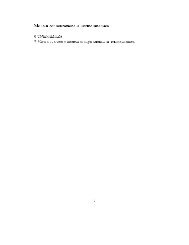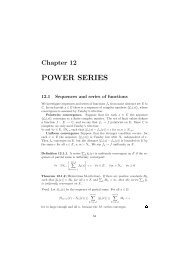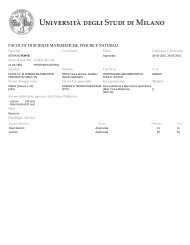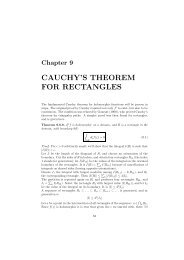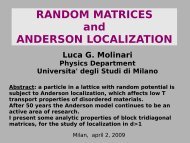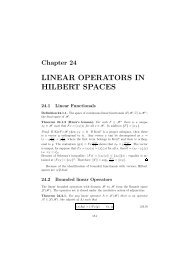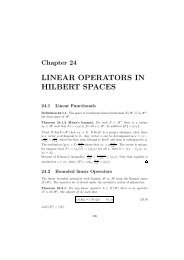THE RESIDUE THEOREM
THE RESIDUE THEOREM
THE RESIDUE THEOREM
Create successful ePaper yourself
Turn your PDF publications into a flip-book with our unique Google optimized e-Paper software.
Chapter 16<strong>THE</strong> <strong>RESIDUE</strong><strong>THE</strong>OREM16.1 Singularities.Definition 16.1.1. When a function f(z) fails to be analytic at a point a, butis analytic in the punctured disk D ′ (a, r) = D(a, r)/{a} (a is removed from thedisk), the point a is an isolated singularity of f.Example 16.1.2. While a holomorphic function f has isolated zeros, the function1/f is holomorphic on the same domain with isolated singularities removed.Laurent’s expansion of a function f that is holomorphic in a punctured diskshows that there are three possibilities:• The point a is a removable singularity if c −k = 0 for all k > 0. An exampleis sin 2 (z − a)/(z − a) 2 .• The point a is a pole of order k if there is k > 0 such that c −k ≠ 0 andc −k−n = 0 for all n > 0. Then, lim z→a (z − a) k f(z) = c −k . An example is1/(z − a) 3 .• a is an essential singularity if for any N there is k > N such that c −k ≠ 0.Remark 16.1.3. There is a substantial difference between a pole and an essentialsingularity. If a is a pole for f, then lim z→a f(z) = ∞. However, if ais an essential singularity, then lim z→a f(z) is undefined. Indeed, a theorem byPicard states that if a is an essential singularity of f, the image f(D ′ ) of thepunctured disk contains all complex points with at most one exception.Exercise 16.1.4. Study the behaviour of the moduli: |1/z| and |e 1/z | for z → 0.Definition 16.1.5. A function is meromorphic on a domain D if it is analyticin D up to a set of isolated poles in D.89
The function g(z) = f(z)− ∑ k P k(z−z k ) is analytic in D. By Cauchy’s theoremit is∫ ∫0 = dζ g(ζ) = dζ f(ζ) − ∑ ∫dζ P k (ζ − z k )γγkγ∫= dζ f(ζ) − 2πi ∑ Res[f, z k ] Ind(γ, z k )γkRecall that the principal series can be integrated term by term (see remark15.1.2) and the integral on a closed curve ∫ γ dζ(ζ − z k) −l = 0 for l ≠ 1 (theprimitive is holomorphic in D/{z k }). For l = 1 the integral is by definition 2πiInd (γ, z k ).16.3 Evaluation of integralsThe residue theorem is a fundamental tool for evaluating integrals on the realline. Let us consider some important examples.Integrals that only involve trigonometric functions may be attacked by writingthem in terms of e ±ix or powers, and putting z = e ix . If x is integratedon [0, 2π], the new variable runs the unit circle C where the residue theoremapplies.∫ 2π01dx2 + cosx∫C=dziz24 + z + 1/z∫C= −2idz(z − z + )(z − z − )Of the two roots z ± = −2 ± √ 3, only z + is in the unit disk, and it is a simplepole. Then:∫ 2π01−2idx = 2πi lim (z − z + )2 + cosx z→z + (z − z + )(z − z − ) = √ 2π3Integrals on the real line like the following one, are attacked by closingthe path with a semicircle in the upper or lower half-plane, promoting the realvariable x to variable z = x+iy (note that dz = dx on the real axis). The residuetheorem applies to the closed path, and equals the integral if the contributionof the semicircle is shown to vanish.∫Rdxx 2x 4 + 1 = limR→∞∫γz 2dzz 4 + 1The piecewise smooth path γ is the segment [−R, R] closed by a semicircle.Since the function decays as R −2 in every direction, it kills for R → ∞ thecontribution of any contour integration (Darboux’s inequality). We are thenfree to close in the upper or lower half plane, and apply the Residue theorem.91
Let’s close in the upper half plane. The path encirles the simple poles z 1 = e iπ/4and z 2 = e 3iπ/4 . Then∫x 2 (z − z 1 )z 2 (z − z 2 )z 2dxx 4 = 2πi lim+ 1 z→z 1 (z 4 + 2πi lim+ 1) z→z 2 (z 4 + 1)RIn the example we were free to choose where to close the path because thefunction decay compensated the length πR. There is an important class ofintegrals where the choice is not free. Such functions are considered in thefollowing useful lemma:Proposition 16.3.1 (Jordan’s lemma). Let f be a complex function continuouson the semicircle z = Re iθ , θ ∈ [0, π], and let M(R) = max θ |f(Re iθ )|. Then:∫ ∣ ∣∣∣ ∣ dzf(z)e iaz ≤ π M(R), a > 0 (16.1)aProof.∫∣γγ∣ ∫ ∣∣∣ πdzf(z)e iaz =∣ iR e iθ dθe iaReiθ f(Re iθ )∣(≤ R max∣ f Reiθ )∣ ∣θ≤ 2R M(R)∫ π/200∫ 2π0−Ra sin θdθedθe −2Raθ/π ≤ π a M(R)Obviously, if the parameter a had the opposite sign, the path for convergenceis the semicircle in the lower half plane.If the maximum M(R) of |f| goes to zero for R → ∞, no matter how fast, thenthe semicircle contribution is zero. Of course, f must decay fast enough on thereal line for the real integral to exist. Here is a relevant example:∫ ∞−∞dx1x 2 + a 2 e−ikx = π a e−a|k| , a > 0, k ∈ R (16.1)For k = 0 one is free to close in the upper or lower half plane. If k ≠ 0, becausee −ik(x+iy) must not blow up, one is compelled to close with a semicirclein the lower half plane (y < 0) if k > 0 or in the upper half plane (y > 0) if k < 0.Integrals on the real line are tacitly defined with limits to infinity being takenindependently: ∫∫ vf(x)dx = lim f(x)dxRu,v→∞−uThe examples presented above, use a weaker definition (Cauchy’s principalvalue):∫∫ RP f(x)dx = lim f(x)dxR R→∞ −R92
where the limits are taken simultaneously. In several cases, the above principalvalue integrals are well defined as ordinary integrals.It is possible to make the statement:Theorem 16.3.2 (Jordan). Let f(z) be analytic, save for isolated singularitiesp 1 , . . .,p n in the upper half plane, and none on the real axis 1 . If f(z) → 0 asz → ∞ in the upper half plane, a > 0 then:∫ ∞−∞dxf(z)e iax = 2πin∑Res[f(z)e iaz , p k ] (16.1)Proof. Consider the rectangular path with corners (−u, 0), (v, 0), (v, iw) and(−u, iw), u, v > 0, w = u + v. The rectangle is large enough to accomodateall singularities in the upper half plane. The integral of f(z)e iaz on this closedpath is 2πi times the sum of residues. Let us show that integration on all sidesbut the interval [−u, v] give zero for u, v → ∞: the integral on the segment fromv to v + iw is∣∣∫ w0k=1∣ ∣∣∣idyf(v + iy)e iav−ay ≤ sup |f(v + iy)|y∫ w0e −ay ≤ 1 a sup |f(v + iy)|,ythe sup factor vanishes for v → ∞ (and u is left free). The opposite side behavessimilarly for u → ∞ and all v. The integral on the side from −u + iw to v + iwis ∣∫ ∣∣∣ v∣ ∣∣∣dxf(x + iw)e iax−aw ≤ e −aw (v + u)sup |f(x + iw)|,x−uand vanishes in the independent limits u and v → ∞.The integral on the whole real axis is obtained by two independent limits∫ 0lim dxf(x)e iax + limu→∞−uv→∞and equals the integral on the closed rectangle.∫ v0dxf(x)e iaxHyperbolic functions are periodic in the imaginary direction, so the previoustrick of adding a contour at infinity does not work (the contribution does notvanish). The periodicity is exploited as in the following example:∫ ∞−∞dx1coshx e−ixy =πcosh( π 2 y) (16.1)The integral on [−R, R] is closed by the rectangle with vertices (±R, 0) and(±R, −iπ), and cosh(x−iπ) = − coshx. The edges are shown to vanish for R →∞. The residue at the simple pole −iπ/2 must be included in the evaluation.1 there may be singularities in the lower half plane as well, but they do not matter if a > 0.93
16.3.1 Enumeration of zeros and polesTheorem 16.3.3. Let f(z) be meromorphic in D, γ a Jordan curve in D. Ifz 1 , . . .z n are the zeros (of order k 1 , . . .,k n ) and p 1 , . . . p m are the poles (of orderq 1 , . . . , q m ),∫dζ f ′ (ζ)γ 2πi f(ζ) = ∑ k i − ∑ q j . (16.1)i jProof. A zero or a pole of f is a pole for f ′ /f. The theorem is an application ofthe theorem of residues. In a neighborhood of a zero z i , f(z) = A i (z −z i ) ki ϕ i (z)with ϕ analytic and no other zeros or poles. Thenf ′ (z)f(z) =k i(z − z i ) + ϕ′ i (z)ϕ i (z)with residue k i . In a neighborhood of a pole, f(z) = B j (z − p j ) −qj φ j (z) with φanalytic, and no other poles or zeros. Thenand the residue is −q j .f ′ (z)f(z) =Exercise 16.3.4. Show that: ∫ |z|=kπ16.3.2 Evaluation of sums−q j(z − z j ) + φ′ j (z)φ j (z)dζ2πitan ζ = −2k.The theorem of residues can be used to evaluate infinite sums by reducing themto sums on a finite number of residues.The functions π cot(πz) and πcosec(πz) are meromorphic with simple poles onthe real axis at z n = n ∈ Z, and residues respectively equal to 1 and (−1) n . Iff(z) is analytic in a neighborhood of an integer, thenf(n) = Res[f(z)π cot(πz), n],(−1) n f(n) = Res[f(z)πcosec(πz), n],Proposition 16.3.5. Let f(z) be meromorphic with a finite set of poles P ={p 1 , . . . , p m } and suppose that there is K > 0 such that |z 2 f(z)| < K for all zwith |z| larger than some constant R. Then0 = ∑0 = ∑n∈Z/Pn∈Z/Pf(n) +(−1) n f(n) +n∑Res [f(z)π cot(πz), p k ] (16.2)k=1m∑Res[f(z)πcosec(πz), p k ] (16.3)k=194
Proof. To apply the theorem of residues, consider a square path □ with corners±[n + 1 2 ± i(n + 1 2 ] big enough to include all poles p k. Then:∫□dζ2πi f(ζ)g(ζ) = ∑ aRes[f(z)g(z), a]where a ∈ {0, ±1, . . ., ±n}∪{p 1 , . . . p m }, and g(z) is either π cot(πz) or πcosec(πz).On the sides of the squares it is | cot(πz)| ≤ 1 and |cosec(πz)| < 1. Then Darboux’sinequality and the bound on f ensure that the contour integral vanishesfor n → ∞:∣ ∣∣∣∫□dζ2πi f(ζ)g(ζ) ∣ ∣∣∣≤4(2n + 1)2πK(n + 1/2) 2Corollary 16.3.6. If p 1 , . . . , p k are not integers, then∞∑n=−∞∞∑n=−∞f(n) = −(−1) n f(n) = −m∑Res [f(z)π cot(πz), p k ] (16.2)k=1m∑Res[f(z)πcosec(πz), p k ] . (16.3)k=1Example 1) f(ζ) = 1/(ζ 2 + z 2 ) has simple poles ±iz.∑ ∞n=−∞ 1n 2 +z= ∑ π cot(πζ)2 p=±izRes[ζ 2 +z, p] = π 2 zcoth(πz). One obtains a representationfor coth(πz):coth(πz) = 1πz + 2z π∞∑n=11z 2 + n 21For |z| < 1 one may expand in geometric series:n 2 +z= ∑ z2l2 l(−1)l . Exchangeof summations is allowed because series are absolutelyn 2+2lconvergent:coth(πz) = 1πz + 2 π∞∑(−1) l z 2l+1 ζ(2 + 2l)l=0The comparison with eq.(12.11) reveals the following relation with Bernoullinumbers:ζ(2l) = 1 (2π) 2l2 (2l)! |B 2l| (16.3)Put iz in place of z and obtain:cot(πz) = 1πz + 2 z π∞∑n=11z 2 − n 2 ;95
z 2 −n 2 = d dz log(z2 − n 2 ), the product for-since cot(πz) = 1 2zπ dzlog sin(πz) andmula results (L. Euler, 1734):dsin(πz) = πz∞∏] [1 − z2n 2n=1(16.3)Example 2) f(z) = z −2 . The function has a pole of order 2 in the origin.∑n≠0 n−2 = −Res[ π cot(πz)z, 0]. The residue is evaluated with the rule for poles2of order 3:ζ(2) = − 1 4 lim d 2 πz cos(πz)z→0 dz 2 sin(πz)A different way to evaluate the residue is to produce the Laurent series directly,π cos(πz)from known series, and read c −1 :z 2 sin(πz) = π[1−(πz)2 /2!+...]z 3 π[1−(πz) 2 /3!+...] = 1z− π23 3z + . . ..Then c −1 = −π 2 /3 and∞∑ 1ζ(2) =n 2 = π26n=116.4 Sokhotsky-Plemelj’s identitiesThe two identities were discovered by Sokhotsky in 1873, and proven rigorouslyabout thirty years later by Josip Plemelj. Given a Cauchy integral on a curve(it can be open or closed)∫dζ f(ζ)F(z) =2πi ζ − z , z /∈ γγand the Hölder condition |f(ζ) −f(ζ 0 )| ≤ A|ζ −ζ 0 | α (A, α > 0) for all ζ, ζ 0 ∈ γ,the identities establish the limits F ± (ζ 0 ) as z approaches a point ζ 0 ∈ γ differentthan endpoints, from the left or the right sides of γ.The identities are frequently used in theoretical physics with the path γ givenby the real axis.A simple proof is given, under the stronger condition that f is analytic in astrip. A different proof will be given in the chapter on tempered distributions.Proposition 16.4.1. Let f(z) be holomorphic in a finite strip 0 < Im z < η(or −η < Im z < 0), and |f(z)| < C for |Rez| > R inside the strip. Thenlimǫ→0 + ∫Rf(x)dxx − y ± iǫ∫R= Pwhere P is Cauchy’s principal part.dx f(x) ∓ iπf(y) (16.3)x − yProof. Consider a rectangular path with corners R, R + iǫ, −R + iǫ, −R. R islarge enough that y ∈ [−R, R]. Deform the path near y with a half-circle with96
−R+iεR+i ε−RδyRFigure 16.1:center y and radius δ < ǫ in upper half plane. By Cauchy’s theorem, since y isnot enclosed by the path γ:∫0 = dζ f(ζ) ∫ y−δγ ζ − y = dx f(x) ∫ R−R x − y + dx f(x) ∫ Ry+δ x − y − f(x + iǫ)dx−R x + iǫ − y∫ π∫ ǫ∫−i dθf(y + δe iθ f(R + is) ǫ) + i dsR + is − y − i f(−R + is)ds−R + is − y00For large R and δ → 0 the first two integrals define the principal part of theintegral on the real line. The integral on the semicircle gives −iπf(y) becausef is continuous and δ → 0. The last two integrals vanish for large R. Finally,for ǫ → 0 it is f(x + iǫ) → f(x). The proof of the identity with opposite sign isvery similar.097



